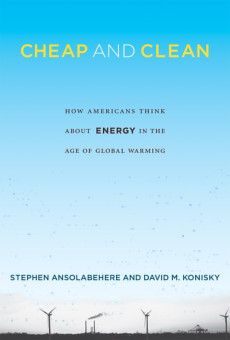
Cheap and Clean: How Americans Think About Energy in the Age of Global Warming
Stephen Ansolabehere & David M. Konisky
272 pages, The MIT Press, 2014
Texas is not known for tree hugging. That made it all the more surprising when, after a multiyear planning process, eight of the state’s largest utilities chose to commit to develop the next 1,000 megawatts of electricity generation using wind. More unusual still was the process by which they came to that decision.
In the summer of 1996, Central Power and Light, West Texas Utilities, Southwest Electric Power Company, El Paso Electric, Entergy Gulf States, Houston Lighting and Power, Texas Utilities, and Southwestern Public Service banded together to conduct a series of “town hall” meetings with customers. The objective of the meetings, simply enough, was to ask the people what they wanted. Over a two-year period, James Fishkin, then a professor at the University of Texas, conducted a series of meetings with relatively small groups of randomly chosen Texans. Rather than merely ask people their opinions, Fishkin brought together advocates of different energy sectors and let them make their best case to the people, and then let the people decide. Before the deliberative poll began, participants were asked their opinions about energy and their willingness to pay for various sources of electricity. Most people initially stated that they would be unwilling to pay higher electricity prices for alternative energies such as wind. By the end of the town meetings, there was a large increase in the percentage of participants who said they wanted to see investment in renewable sources as well as energy efficiency.
Trailing by a large margin were fossil fuel plants. Largely on the basis of this exercise, the participating utilities expanded their investment in renewable sources of electricity generation, mostly in the form of wind power. “Initially I was skeptical,” said the Texas Public Utility Commission’s chair Pat Wood, “but the results have been extraordinary.”
Today, Texas leads the nation with 10 gigawatts of wind-generated electricity, and the market for wind in Texas is booming. Shell and TXU Corporation are now planning a 3-gigawatt wind farm in the Texas Panhandle. Not to be outdone, T. Boone Pickens is planning a 4-gigawatt plant in the Panhandle.
The story of how Texas became a leader in wind energy is certainly unusual. State legislators, public utility commissions, and other policy makers do not normally conduct extensive polling or focus group campaigns to figure out what energy policy should be. Texas, however, is the exception that proves the general rule. Public opinion plays a central role in shaping the development of the energy sector and the rules governing the environmental consequences of energy production.
At times, the American public spurs the government to develop new energy sources and move in new directions, as was the case with wind in Texas and with the adoption of renewable energy mandates in over thirty states. At other times, the American public acts as a brake to slow or even stop development of some technologies, as was the case with nuclear power in the 1980s and 1990s. Technology, economics, finance, and many other factors certainly shape what options are feasible for the energy industry, but the development of new energy resources is also intensely political. New power plants must navigate through substantial regulatory and political hurdles related to siting, permitting, and rate setting, a process that can take up to a decade for a given plant. The public, acting as voters and consumers, often gives industry and utility commissions and state legislatures the ultimate push toward one technology over others, and the public’s approval can accelerate political acceptance of power plants, pipelines, and other needed infrastructure development.
The technology options today are well-understood. But, we know very little about what Americans want when it comes to energy, and how these preferences vary across different sources. What if we conducted a national deliberative poll? What would Americans want to do? Would they favor a continued reliance on fossil fuels such as coal and natural gas, more use of nuclear power, or perhaps a shift toward renewable sources such as wind and solar power? Surprisingly, survey researchers have not conducted systematic comparisons of various energy sources. Rather, most research has focused on specific fuels, especially nuclear power; on events, such as Three Mile Island or the Exxon Valdez Oil spill; on energy providers, including companies and utilities; or on unique aspects of energy, such as opening up the Arctic National Wildlife Refuge for drilling. The baseline comparisons of different fuels that Fishkin did in the Texas deliberative poll have not been measured on a national scale and in such a way that we could begin a national dialogue about where the public wants energy policy to take us.
In this chapter, we begin to paint a picture of U.S. public opinion about the energy sources used to generate electricity. Several key themes emerge. First, Americans want less reliance on traditional fossil fuels, especially coal and oil, and prefer more of what it is “new,” particularly renewable sources such as wind and solar power. Second, these preferences reflect a long-standing desire among the U.S. public to shift U.S. energy consumption from dirtier to cleaner fuels, a desire that dates back many decades. In fact, to the extent to which we can track attitudes over time, we find tremendous stability in opinions about energy. Putting these pieces together, Americans express a clear dissatisfaction with the energy status quo. Americans want a different future, but they harbor some doubts about whether such a future will materialize.
Excerpted from Cheap and Clean: How Americans Think about Energy in the Age of Global Warming by Stephen Ansolabehere and David M. Konisky, published by The MIT Press (http://mitpress.mit.edu/books/cheap-and-clean) in 2014. Copyright © The MIT Press. All rights reserved.

